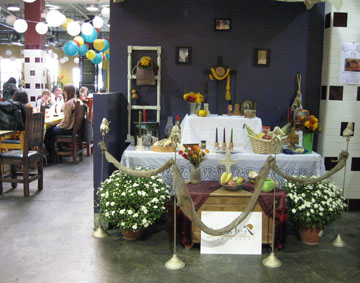Listen to an audio story by Annenberg Radio News
 Dia de los Muertos fills Los Angeles with altars, sugar skulls and yellow marigolds on the first two days of November each year. But recently, the Mexican holiday has become increasingly popular.
Dia de los Muertos fills Los Angeles with altars, sugar skulls and yellow marigolds on the first two days of November each year. But recently, the Mexican holiday has become increasingly popular.
The Day of the Dead is at least a two-day affair. According to the holiday’s tradition, souls of deceased children returned to earth today, and they’ll be joined by families’ other ancestors overnight.
But at the South LA marketplace Mercado la Paloma, this year’s festival is much bigger than its Mexican roots.
Celebrations, art and food are bringing people from all kinds of backgrounds together, said Gilberto Cetina. He owns Chichen Itza, a restaurant within in the Mercado.
“White people, Asian people, Indian people, Latin people… it’s really a multicultural event. it doesn’t matter where you’re from, or if you sing in English or Spanish.”
This year, Gilberto is serving a special tamale pie called Mucbil Pollo. It’s what families in the Yucatan region of Mexico used to leave with their ancestors’ bodies while their souls waited for the afterlife. They still leave it on their altars. And people love it.
“The Mayans had a tradition to leave a corn on the mouth of the body, to feed the body. And now that corn dog is a little bit more sophisticated, and it’s a tamale pie.”
Visitors have plenty to see, too. Altars for families’ ancestors line the walls, and each one uses different fabric, pictures and relics based on what their ancestors loved.
Damon Turner is the Mercado’s Arts and Cultural Program Director. He helped set up the altars and a festival this past weekend. As a kid, his family didn’t even celebrate Halloween.
But Dia de los Muertos is special, he thinks, because it recognizes such common ground: family and death.
“I think the idea of Dia de los Muertos is really like celebrating that which is taboo, typically, in America, which is death. It’s looking at death as a place of strength, a place where we can build community with each other – and, yeah, have some good food while we’re doing it.”
Dia de los Muertos ends tomorrow – but Gilberto’s tamale pie will be back at the Mercado la Paloma next year.















